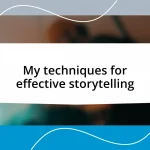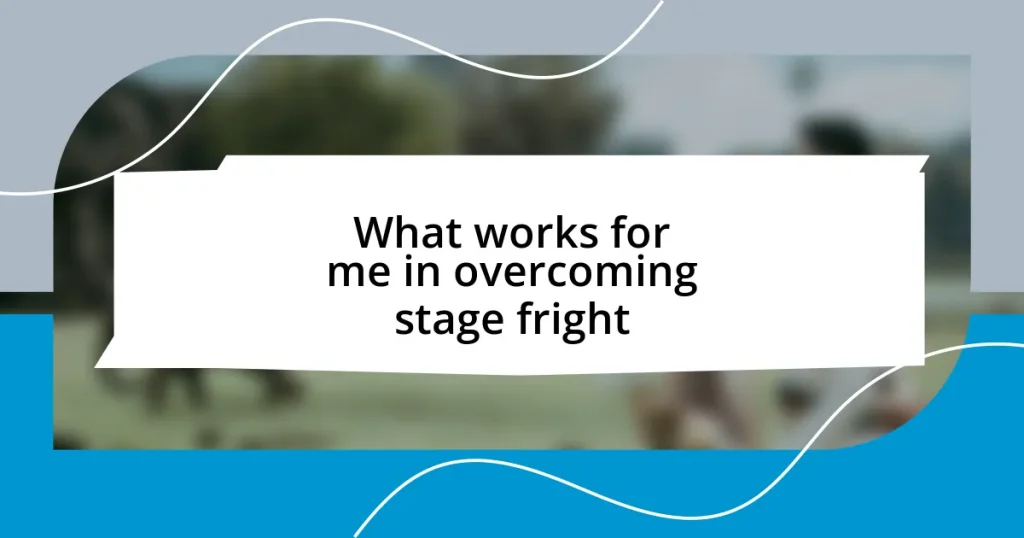Key takeaways:
- Confidence significantly influences our daily interactions and how we face challenges, making it a skill that can be cultivated over time.
- Recognizing personal strengths and weaknesses through self-reflection, feedback, and journaling empowers individuals to improve and take on challenges.
- Setting achievable, specific, and time-bound goals can systematically enhance confidence, transforming small actions into a foundation for greater self-assurance.
- Surrounding oneself with supportive and positive people fosters growth in confidence and encourages individuals to pursue their goals more boldly.

Understanding the importance of confidence
Confidence plays a crucial role in our daily lives, influencing how we approach challenges and interact with others. I remember a time when I had to give a presentation at work. The moment I stepped up feeling confident, everything changed. I engaged the audience, expressed my ideas clearly, and the feedback was overwhelmingly positive. Isn’t it fascinating how our mindset can shift the outcome of a situation?
When we think about confidence, it’s more than just feeling good about ourselves; it’s about believing that we can handle whatever life throws our way. During moments of self-doubt, I often ask myself, “What would I do if I believed in my abilities?” This question has led me to take risks that I would have otherwise avoided. By shifting my perspective, I’ve learned that confidence is not simply a personality trait but a skill that can be cultivated over time.
Moreover, confidence can significantly impact our relationships. I’ve noticed that when I approach conversations with self-assurance, people respond more positively. It creates a ripple effect, fostering an environment of trust and openness. Have you ever noticed how someone’s confidence can make you feel more at ease? It’s a powerful dynamic that emphasizes the importance of nurturing our own self-belief.

Recognizing personal strengths and weaknesses
Recognizing my personal strengths and weaknesses has been an enlightening journey. I used to shy away from self-assessment, thinking it was too introspective, but facing this reality has allowed me to grow. When I first identified that I excel in creative problem-solving but struggle with time management, it was like lifting a weight off my shoulders. I realized that acknowledging both sides gives me a clearer path to self-improvement.
Here are some key elements I focus on to gain this recognition:
– Self-Reflection: I take time each week to reflect on my experiences and decisions, asking what went well and what needs work.
– Feedback from Others: I seek constructive criticism from trusted friends or colleagues—it’s eye-opening to hear how others perceive my strengths and weaknesses.
– Journaling: I keep a journal to document moments of success and challenge, helping me spot patterns over time.
– Strength-Focused Planning: I develop strategies that play to my strengths while incorporating tools or resources that help manage my weaknesses.
– Mindfulness Practices: Engaging in mindfulness helps me stay grounded, allowing me to assess my abilities without judgment.
By embracing this holistic view of myself, I feel more empowered to tackle challenges and celebrate my accomplishments.

Setting achievable confidence goals
Setting achievable confidence goals is essential for fostering a positive mindset. I remember a time when I decided to smile at strangers while walking down the street. It seemed like a small task, but it pushed me out of my comfort zone. Each smile sparked a connection, and with every response I received, I felt a little surge of reassurance. The act of setting such a simple goal transformed how I perceived social interactions and made me realize that confidence can be built through manageable steps.
In my experience, breaking down larger confidence aspirations into smaller, easily attainable goals has been key. For instance, instead of saying, “I want to be confident in public speaking,” I set a goal to speak up once in each meeting. This smaller commitment felt less overwhelming and allowed me to celebrate each opportunity I took. Each small win compounded and helped fortify my self-assurance. Have you ever tackled a goal this way? When I focused on achievable actions, I’d notice a shift not just in my confidence but in my enthusiasm for taking on new challenges.
When it comes to setting these goals, I believe it’s crucial to make them specific and time-bound. I started with goals like, “I will join a group discussion every Monday.” This structure kept me accountable, and I could measure my progress over time. I recall the thrill of seeing the gradual change in myself. Embracing this approach made me realize that confidence isn’t an abstract idea; it’s about actively engaging in behaviors that cultivate it.
| Goals | Examples |
|---|---|
| Small Steps | Smiling at strangers |
| Break Down Larger Goals | Speaking up in meetings |
| Specific & Time-bound | Join discussions every week |

Practicing positive self-talk techniques
Practicing positive self-talk has been a game-changer for my confidence. Whenever I catch myself spiraling into negative thoughts, I pause and replace them with affirmations. For example, instead of thinking, “I can’t do this,” I’ll say, “I am capable and prepared for this challenge.” This simple shift makes a world of difference in how I approach tasks, giving me the mental clarity to tackle them effectively.
One technique that resonates with me is the “three positives” method. Each morning, I jot down three things I appreciate about myself. It can be something as basic as “I’m good at listening” or “I handled that situation well yesterday.” This practice not only sets a positive tone for my day, but it also trains my mind to focus on strengths rather than flaws. Have you tried something similar? I found that, over time, these small affirmations seep into my subconscious, boosting my overall sense of self-worth.
Additionally, I utilize visualization as a form of positive self-talk. Before entering challenging situations, I envision myself succeeding. I remember preparing for a presentation where nerves were definitely creeping in. I pictured myself confidently engaging with the audience, which reassured me that success was within reach. This visualization technique helps replace anxiety with anticipation, making me feel prepared and empowered when it counts. How powerful would it be for you to visualize your success before stepping into a daunting situation? It’s definitely worth exploring!

Engaging in confidence-building activities
Engaging in confidence-building activities can take many forms. I recall when I took up dancing, something I had always admired but never dared to try. Walking into that dance class felt like stepping onto a very unfamiliar stage. At first, I was terrified, but as I started to move and groove, something shifted; the music enveloped me, and it became less about being perfect and more about expressing myself. Each class gave me a little more confidence to just be me, covered in laughter and joyous mistakes.
Another way I’ve nurtured my confidence is through volunteering. A few years back, I committed to helping at a local community center. It amazed me how stepping outside my own worries to assist others not only built my confidence but also reinforced my sense of purpose. Have you thought about how helping others might change your own perspective? I found that engaging in activities like organizing events gave me a sense of achievement. The gratitude I received from those I helped was a powerful reminder that my contributions mattered, which in turn made me feel capable of tackling my own challenges.
Lastly, I believe that participating in group activities can be incredibly beneficial. For instance, joining a hiking club not only pushed me physically but also socially. I remember my first hike; I was nervous about being the slowest one in the group. Yet, as we trekked through the beautiful trails, sharing stories and laughter, I realized that my pace wasn’t what mattered most. Each person’s support helped build my confidence in outdoor adventures. Have you ever stepped out of your comfort zone like that? Discovering new hobbies alongside others who share your interests can create bonds that lift us all.

Surrounding yourself with supportive people
Surrounding yourself with supportive people is essential for building confidence. I remember joining a writing group a few years back, feeling apprehensive at first. However, the encouragement I received from fellow writers was transformative. Their praise for my work, no matter how small, lifted my spirits. It made me wonder, could I achieve greater heights with a solid support system around me? Absolutely!
I’ve also found that spending time with individuals who uplift me can be a game-changer. When I’m surrounded by positive influences, I feel more encouraged to take risks. For instance, during one of my career transitions, my closest friends reminded me of my strengths, helping me push through self-doubt. Seeing how they believed in me ignited a spark in my confidence. Have you thought about how your friends impact your mindset? It’s remarkable how their faith in our abilities can shift our own perceptions.
Moreover, I think it’s important to evaluate and sometimes redefine your circle. I had a moment when I realized that some friendships were more draining than uplifting. Making space for people who inspire growth and positivity has been one of my best decisions. It’s incredible how the right company can embolden you to chase your dreams. Have you experienced similar realizations in your life? Surrounding yourself with those who genuinely support you is a fundamental step toward lasting confidence.














